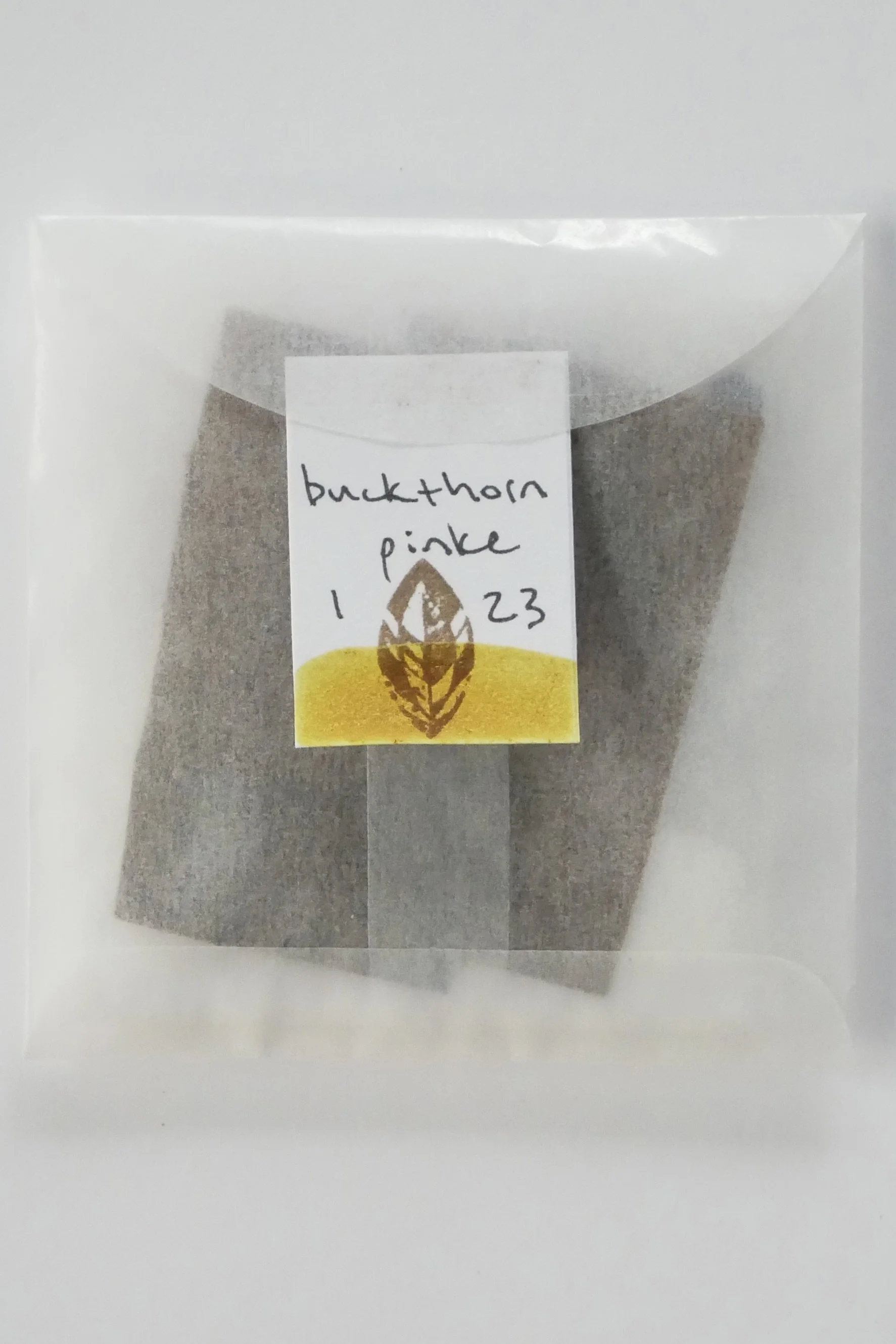buckthorn pinke : january ’23
This month’s pigment, Buckthorn Pinke, is presented to you with an invitation to explore it in two different forms: as an ink and as a lake pigment. The packet contains two ‘clothlets,’ a vehicle for ink transport used by medieval monks, wherein a small cloth is saturated in a concentrated ink and dried. The packet also contains two white powders: alum & soda ash, both of which come from large mines. Alum is sometimes used to make pickles, and soda ash is a form of baking soda. The powders can be used to transform the dark brown of the buckthorn ink clothlets into a bright, luminous lemon yellow.
The Buckthorn ink is made with Common Buckthorn (Rhamnus cathartica), which was introduced to this large continent (known as ‘North America,’ by Euro culture & sometimes called by the name given to it by the Haudenosaunee Nation: ‘Turtle Island’) in the 1800s. These days the plant is disliked by humans because it spreads rapidly and crowds out botanical biodiversity. Its berries cause diarrhea in humans and birds, so it’s considered ‘mildly poisonous’ (do not eat! ). Tilke and Tilke’s partner Noelle picked these berries on the side of a dirt road in Wabanaki territory / Vermont where Tilke learned to ride a bike as a kid.
Buckthorn berries (Rhamnus saxatilis) were used historically in Europe to make a yellow color, also known as ‘still de grain yellow’ or ‘dutch pinke,’ at a time when the term ‘pinke’ referred to its method of manufacture and not its color (there were brown, yellow and pink pinkes). The berries themselves contain an array of hidden colors which respond to changes in ph. The berry juice in these clothlets started out deep purple, then turned dark green, then warm russet, and, when laked, will be yellow.
contributor: Tilke Elkins
Tilke Elkins is a bi-coastal artist, writer, educator and curator focused on site-specific/site-responsive painting and social practice art. Tilke has worked with mineral and botanical pigments since 2007, and is the founding director of Wild Pigment Project. Established in 2019, Wild Pigment Project has been instrumental in bringing together the global pigment community by providing an ever-growing directory of international artists and educators, and facilitating networking and collaborations worldwide. Tilke teaches regular workshops about material ecology and reciprocal relationship with land, land histories and wild pigments and has lectured, led discussions, and taught workshops at the University of Oregon, Pacific Northwest College of Art, Portland Community College, Lewis and Clark College, and the Institute of American Indian Arts. She offers online and in-person courses, mentorships, and private consultation to support artists and organizations seeking to integrate wild pigments into studio practice and programming. www.tilkeelkins.com
Photo courtesy of Tilke Elkins.
22% donation recipient : Abenaki Nation of the Missisquoi
‘The Abenaki Nation of Missisquoi is a community of extended families who has inhabited the Missisquoi River and the Bitawbagw (Lake Champlain) Valley for thousands of years. We have maintained this land, our relations with each other, and with the many other-than-human beings who live here, through every generation. […] We are one of many communities in Wabanaki, the land of the dawn. […] Missisquoi has always been maintained as a central gathering place, for families who have always lived here and those that became a part of the community. The land has sustained us all and we have worked hard to sustain the land. Abenaki men were among the first guides in the Missisquoi Wildlife Refuge and worked to ensure that Abenaki families continued to have access to the wetlands for fishing and hunting, when the federal government established the Refuge in the 1940s. Abenaki women leaders, like Martha Morits Lampman, worked to maintain their homes and extended families in places like the Maquam wetlands, ensuring that both Abenaki people and the animals and plants on which we rely would be protected. This land, known as “Grandma Lampman’s,” was permanently protected by the Abenaki community, and recognized by the state of Vermont, in the 1990s.Today, we continue to put the needs of our extended families at the center, with projects like Maquam Bay of Missisquoi, the Abenaki Food Pantry, Community gatherings, and wellness and cultural programs.’ ~ from www.abenakination.com




